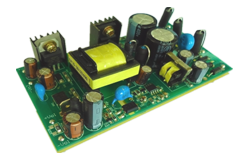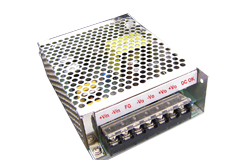nuus
Efficient AC-DC Converter for Industrial Applications
Author: ZYG Power Module Time: 2023-5-24
In this modern era, the use of electronic devices has become a common practice in various fields, including industrial applications. To operate these devices, there is a need for a reliable and efficient power supply. An AC-DC converter is an essential component that transforms the alternating current (AC) power into direct current (DC) power, which is suitable for most electronic devices. However, the efficiency of such converters is critical, as it directly affects the performance and reliability of the electronic devices. Therefore, designing an efficient AC-DC converter for industrial applications is essential.
The efficiency of an AC-DC converter is determined by its power dissipation during the conversion process. The power dissipation can be reduced by minimizing the conversion losses, which occur due to the switching of the power semiconductor devices, such as diodes and transistors. In addition, the efficiency can be improved by reducing the conduction losses, which occur due to the resistance of the power devices and the conductors. Therefore, the design of an efficient AC-DC converter should focus on reducing both the conversion and conduction losses.
One of the ways to reduce the conversion losses is to use high-frequency switching, which allows for smaller and more efficient power devices. However, high-frequency switching also increases the conduction losses due to the increased switching frequency. Therefore, a trade-off between conversion and conduction losses must be considered during the design process. In addition, the use of advanced power devices, such as silicon carbide (SiC) and gallium nitride (GaN), can significantly reduce both the conversion and conduction losses.
Another way to improve the efficiency of an AC-DC converter is to use a resonant converter topology, which allows for zero-voltage switching (ZVS) or zero-current switching (ZCS). ZVS and ZCS reduce the switching losses by allowing the power devices to switch when the voltage or current is zero, thereby minimizing the power dissipation during the switching process. In addition, resonant converters also reduce the electromagnetic interference (EMI) generated during the switching process, which is essential for industrial applications.

The selection of the suitable topology for an AC-DC converter depends on various factors, such as the input voltage and current, the output voltage and current, the load requirements, and the desired efficiency. Some of the commonly used topologies for industrial applications include the flyback converter, the forward converter, the push-pull converter, and the half-bridge converter. Each topology has its advantages and disadvantages, and the selection should be based on the specific requirements of the application.
In conclusion, the design of an efficient AC-DC converter for industrial applications requires careful consideration of various factors, including the power dissipation, the switching losses, the conduction losses, and the EMI. The use of advanced power devices, high-frequency switching, and resonant converter topologies can significantly improve the efficiency of the converter. The selection of the suitable topology should be based on the specific requirements of the application. A well-designed AC-DC converter can ensure the reliable and efficient operation of electronic devices in industrial applications.
vorige: How to Convert 110V AC to 12 Volt DC: A Step-by-Step Guide
volgende: Efficient 120V AC to 12V DC Converter for Reliable Power Supply
relevante inligting
-
2023-8-16
AC/DC Power Supply Module manufacture: Ensuring Reliable and Efficient Power Conversion
Introduction In today's technology-driven world, the demand for reliable and efficient power conversion has never been higher. From small electronic devices to large industrial systems, the proper functioning of power supply modules is crucial to ensure smooth operations. One such module that has gained significant popularity is the AC/DC power supply module. This article aims to delve deeper into the functioning, benefits, and applications of this essential component. Understanding AC/DC Power Supply Module The AC/DC power supply module is a device that converts alternating current (AC) into direct current (DC), making it suitable for various electronic applications. It typically comprises a rectifier, filter, and regulator circuitry to ensure a stable output voltage and current. By converting the AC power from...
Sien besonderhede -
2023-5-19
Efficient 110V AC to 12V DC Power Converter for Optimal Energy Conversion
The Efficient 110V AC to 12V DC Power Converter is an essential device for both home and professional use. This power converter enables optimal energy conversion from the AC current in your wall outlet to a DC current that\'s suitable for powering your electronics, appliances, and other gadgets. In terms of energy conversion efficiency, the 110V AC to 12V DC Power Converter is a compact device that offers a very impressive conversion ratio. Most efficient models have a green performance level over 80%, providing a reliable and advanced DC conversion solution that performs optimally each time you plug something in. The power converter sheds off any extra down-voltage ensuring all electronics function smoothly. Ideally, some equipment does not like nonlinear...
Sien besonderhede -
2022-11-17
As jy 'n kragmodule wil ontwerp, watter aspekte moet in ag geneem word?
As jy 'n skakelkragtoevoer tegniese ingenieur is, hoef jy nie na die bekendstelling van kragmodules te kyk nie. Wanneer jy nog 'n beginner is, of SCM-ontwerp leer, is dit die beste om woord vir woord af te kyk. Hoe om die regte kragmodule te kies Beginsel en tegnologie van stroombaanontwerp Slegs vanuit 'n professionele oogpunt kan die beginsel van stroombaan- en stroombaankwaliteit onderskei word. Tans kan die kragmodule in twee tipes verdeel word: kaal plaat en gevulde seël. Die kaal bord kan op 'n intuïtiewe manier in twee tipes verdeel word, soos redelike, ordelike, vrygewige, ordelike uitleg van elektroniese komponente, helder sweisvlek en reguit. Die verpakking en verseëling...
Sien besonderhede -
2023-6-27
120V AC to 12V DC Converter: Transforming Voltage for Your Electrical Needs
When it comes to powering electrical devices, one of the most important considerations is voltage. Different devices operate at different voltage levels, and it's crucial to ensure that the voltage supplied is appropriate for the specific application. In some cases, it may be necessary to transform voltage to meet the needs of a particular device. This is where a 120V AC to 12V DC converter comes in. A 120V AC to 12V DC converter is a device that takes input from a standard 120V AC power outlet and transforms it into a lower voltage level of 12V DC. This is useful for a variety of applications, including powering devices like routers, modems, and other small electronics. It's also used in...
Sien besonderhede -
2023-6-7
How to Convert 110V AC to 12V DC?
Converting 110V AC to 12V DC is a process that is often necessary when it comes to powering certain electronic devices and appliances. While it may seem like a complicated process, it is actually quite simple and can be done using a few basic tools and materials. In this article, we will go over the steps you need to follow to convert 110V AC to 12V DC. Step 1: Gather Your Materials Before you begin, you will need to gather all the materials you will need for the conversion process. These materials include a step-down transformer, a rectifier, filter capacitor, and voltage regulator. You will also need a soldering iron, solder, wire, and a multimeter. Step 2: Connect the Transformer...
Sien besonderhede -
2023-6-22
Bi-Directional DC-DC Converter: Efficient Energy Transfer in Both Directions
As the global demand for renewable energy continues to increase, the need for efficient energy transfer becomes more critical. One essential element in the energy transfer process is the DC-DC converter. The DC-DC converter is a device used to convert DC voltage from one level to another. It\'s used in many applications, including renewable energy systems, automotive, aerospace, and telecommunications. In recent years, there has been a growing interest in bi-directional DC-DC converters. A bi-directional DC-DC converter is a device that can transfer energy in both directions, from the power source to the load and vice versa. This type of converter is particularly useful in renewable energy systems, where energy is generated by solar panels or wind turbines and stored...
Sien besonderhede


















